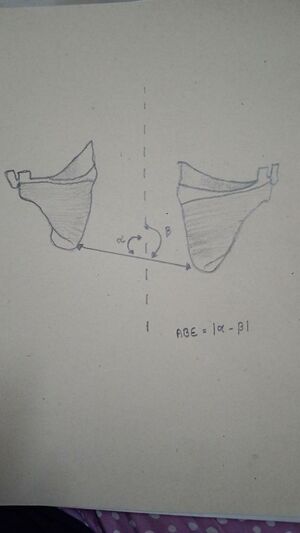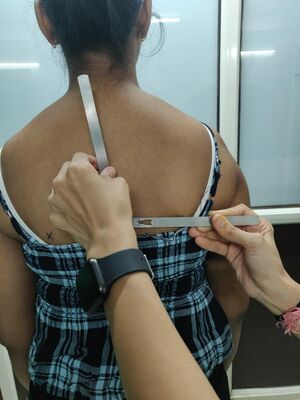Scapular balance angle
Original Editor - Ruchi Desai
Top Contributors - Ruchi Desai
Introduction[edit | edit source]
A new indicator of scapular dyskinesia called the scapular balance angle (SBA) was presented among the findings of the study. This represented the difference between the angles formed by the line joining the 2 inferior angles of the scapula with the vertical line passing through the spine.
The usefulness of an angle in the diagnosis of scapular dyskinesia is extensive, due to its simple calculation and independence from size and weight.
SBA was defined as “the difference between the angles formed by the line joining the 2 inferior angles of the scapula with the vertical line passing through the spine”[1]
Purpose[edit | edit source]
The condition of altered scapular mechanics and motion is called ‘scapular dyskinesis’, where ‘dys’ indicates alteration and ‘kinesis’ indicates motion.
It can be found in healthy individuals or be responsible for a syndrome characterised by several symptoms called SICK. (Scapular malposition, Inferior medial border prominence, Coracoid pain and malposition, and Dyskinesis of scapular motion).
It is a collective term that refers to the movement of the scapula that is dysfunction[1]
Technique[edit | edit source]
The Scapular balance angle measurement was obtained with the patient standing on both bare feet, with arms, pelvis, and heels together. Next, the inferior angle of the scapula was marked bilaterally and the line connecting these marks and another vertical line between the C7 and T9---T10 spinous processes were drawn. Lastly, the angles formed by the line joining both inferior angles of the scapula with the vertical line running through the spine were measured with the goniometer. The SBA was defined as ‘‘the difference between the angles formed by the line joining the 2 inferior angles of the scapula with the vertical line passing through the spine. SBA greater than 7 ◦ would entail the diagnosis of scapular dyskinesia[1].
Manual measurement of the SBA is reproducible at an intraobserver (ICC: 0.87) and interobserver (ICC: 0.84) level.[1]
This criterion presented a sensitivity of 72.73%, specificity of 90.91% and odds ratio of 8[1].








